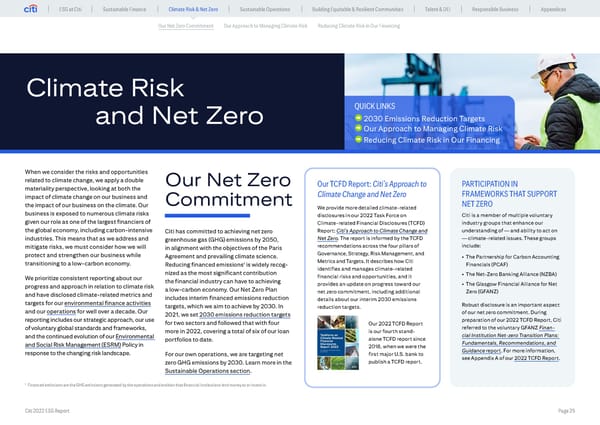ESG at Citi Sustainable Finance Climate Risk & Net Zero Sustainable Operations Building Equitable & Resilient Communities Talent & DEI Responsible Business Appendices Our Net Zero Commitment Our Approach to Managing Climate Risk Reducing Climate Risk in Our Financing Climate Risk QUICK LINKS and Net Zero 2030 Emissions Reduction Targets Our Approach to Managing Climate Risk Reducing Climate Risk in Our Financing When we consider the risks and opportunities related to climate change, we apply a double Our Net Zero Our TCFD Report: Citi’s Approach to PARTICIPATION IN materiality perspective, looking at both the Climate Change and Net Zero FRAMEWORKS THAT SUPPORT impact of climate change on our business and Commitment the impact of our business on the climate. Our We provide more detailed climate-related NET ZERO business is exposed to numerous climate risks disclosures in our 2022 Task Force on Citi is a member of multiple voluntary given our role as one of the largest financiers of Climate-related Financial Disclosures (TCFD) industry groups that enhance our the global economy, including carbon-intensive Citi has committed to achieving net zero Report: Citi’s Approach to Climate Change and understanding of — and ability to act on industries. This means that as we address and greenhouse gas (GHG) emissions by 2050, Net Zero. The report is informed by the TCFD — climate-related issues. These groups mitigate risks, we must consider how we will in alignment with the objectives of the Paris recommendations across the four pillars of include: protect and strengthen our business while Agreement and prevailing climate science. Governance, Strategy, Risk Management, and • The Partnership for Carbon Accounting transitioning to a low-carbon economy. Reducing financed emissions1 is widely recog- Metrics and Targets. It describes how Citi Financials (PCAF) nized as the most significant contribution identifies and manages climate-related We prioritize consistent reporting about our financial risks and opportunities, and it • The Net-Zero Banking Alliance (NZBA) the financial industry can have to achieving provides an update on progress toward our • The Glasgow Financial Alliance for Net progress and approach in relation to climate risk a low-carbon economy. Our Net Zero Plan and have disclosed climate-related metrics and net zero commitment, including additional Zero (GFANZ) includes interim financed emissions reduction details about our interim 2030 emissions targets for our environmental finance activities targets, which we aim to achieve by 2030. In reduction targets. Robust disclosure is an important aspect and our operations for well over a decade. Our 2021, we set 2030 emissions reduction targets of our net zero commitment. During reporting includes our strategic approach, our use for two sectors and followed that with four Our 2022 TCFD Report preparation of our 2022 TCFD Report, Citi of voluntary global standards and frameworks, more in 2022, covering a total of six of our loan is our fourth stand- referred to the voluntary GFANZ Finan- and the continued evolution of our Environmental portfolios to date. alone TCFD report since cial Institution Net-zero Transition Plans: and Social Risk Management (ESRM) Policy in 2018, when we were the Fundamentals, Recommendations, and response to the changing risk landscape. For our own operations, we are targeting net first major U.S. bank to Guidance report. For more information, zero GHG emissions by 2030. Learn more in the publish a TCFD report. see Appendix A of our 2022 TCFD Report. Sustainable Operations section. 1 Financed emissions are the GHG emissions generated by the operations and entities that financial institutions lend money to or invest in. Citi 2022 ESG Report Page 25
 Global ESG Report 2022 Citi Bookmarked Page 24 Page 26
Global ESG Report 2022 Citi Bookmarked Page 24 Page 26